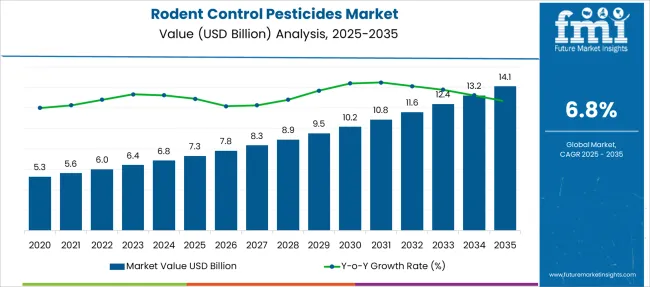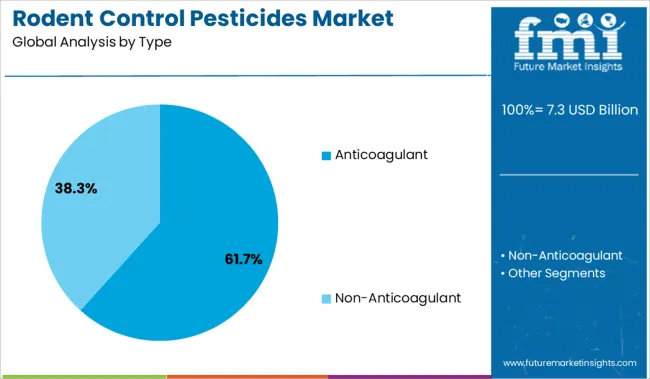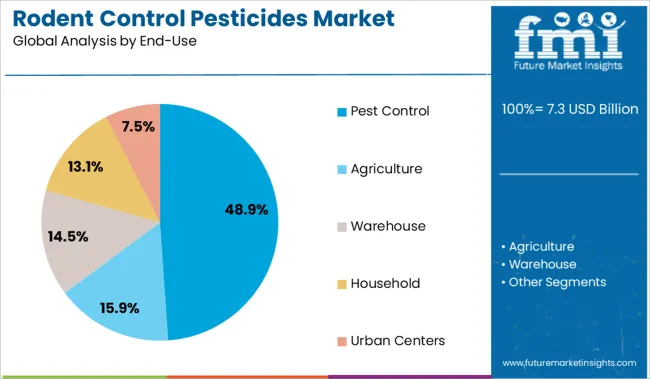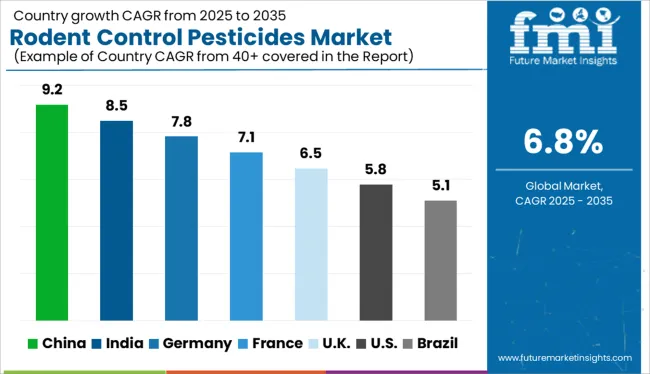The Rodent Control Pesticides Market is estimated to be valued at USD 7.3 billion in 2025 and is projected to reach USD 14.1 billion by 2035, registering a compound annual growth rate (CAGR) of 6.8% over the forecast period.

| Metric | Value |
|---|---|
| Rodent Control Pesticides Market Estimated Value in (2025 E) | USD 7.3 billion |
| Rodent Control Pesticides Market Forecast Value in (2035 F) | USD 14.1 billion |
| Forecast CAGR (2025 to 2035) | 6.8% |
The rodent control pesticides market is growing steadily due to the increasing need for effective pest management solutions in residential, commercial, and agricultural settings. Rising concerns about public health risks and property damage caused by rodent infestations have intensified demand for reliable control products.
Advances in pesticide formulations and delivery systems have improved efficacy and safety profiles, encouraging wider adoption. Regulatory agencies are enforcing stricter guidelines on pest control practices, pushing for environmentally responsible and targeted rodent management solutions.
Additionally, growing urbanization and expansion of food production industries have increased exposure to rodent-related issues. Future growth is expected to be supported by technological innovations in active ingredients and application methods, alongside increased awareness of integrated pest management strategies. Segment growth is projected to be driven by the Anticoagulant type segment and the Pest Control end-use segment, reflecting their effectiveness and extensive application.
The market is segmented by Type and End-Use and region. By Type, the market is divided into Anticoagulant and Non-Anticoagulant. In terms of End-Use, the market is classified into Pest Control, Agriculture, Warehouse, Household, and Urban Centers. Regionally, the market is classified into North America, Latin America, Western Europe, Eastern Europe, Balkan & Baltic Countries, Russia & Belarus, Central Asia, East Asia, South Asia & Pacific, and the Middle East & Africa.

The Anticoagulant segment is expected to hold 61.7% of the rodent control pesticides market revenue in 2025, maintaining its position as the dominant pesticide type. This segment’s growth can be attributed to the high effectiveness of anticoagulants in controlling rodent populations by disrupting blood clotting processes.
Anticoagulant pesticides are favored due to their ability to control a wide range of rodent species and their relatively slow action which reduces bait shyness. Pest management professionals often rely on anticoagulants as part of integrated control programs.
Additionally, improvements in formulations have enhanced safety for non-target species and reduced environmental impact. These factors combined have reinforced the popularity of anticoagulant pesticides in both urban and agricultural pest control.

The Pest Control segment is projected to account for 48.9% of the rodent control pesticides market revenue in 2025, retaining its leadership in end-use applications. Growth in this segment has been driven by the continuous demand for effective rodent management in residential and commercial environments.
Pest control service providers have increasingly adopted rodent pesticides to meet customer needs for safe and long-lasting solutions. Public awareness of health risks associated with rodent infestations has contributed to higher spending on professional pest control services.
Furthermore, regulatory support for pest control initiatives has encouraged the use of registered pesticides with proven efficacy. As urban areas expand and infrastructure ages, the Pest Control segment is expected to maintain its significant share due to the ongoing necessity of rodent management.
As per the Rodent Control Pesticides Market research by Future Market Insights - a market research and competitive intelligence provider, historically, from 2020 to 2024, the market value of the Rodent Control Pesticides Market increased at around 6.3% CAGR.
The population of rodents is constantly increasing. This has caused an upsurge in diseases such as plague, Lassa fever, and hantavirus infection, all of which are harmful to the environment, people, and animals. As a consequence, Rodent Control Pesticides are widely employed in different rodent control solutions used in industrial, residential, and commercial settings.
Rodent-resistant products are in high demand in key cities across the globe as Rodent Control Pesticides are routinely used by pest control organizations. The rising demand for grains as a consequence of the world's expanding population, as well as the development of food storage capacity as a result of growing concern about food security, are major factors driving the growth of the global rodenticide market.
The market for Rodent Control Pesticides is carefully controlled. The toxicity level of Rodent Control Pesticides varies from place to place. However, the harmful effects of Rodent Control Pesticides on children and domestic animals are limiting their widespread usage in the home.
Climate change is driving an increase in worldwide rat populations, which has been a key public health issue. Environmental variables are making the hantavirus infection more vulnerable.
Rodent populations react more rapidly to favorable weather conditions, such as abundant rainfall, which may directly or indirectly transmit rodent-borne illnesses such as spirosis, zoonotic bacterial disease with unknown but presumably high human and veterinary prevalence.
The entertainment business, warehouses, construction firms, foodservice segment, pharmaceutical companies, and hotel industry are all important in expanding demand for pest management products and services, particularly for rats.
Economic losses from pests such as rats have an influence on the tourism industry. The growth of the hotel and entertainment businesses in urban areas has raised the demand for rodent control solutions, owing to the customers’ high purchasing power.
Resistance has developed in some rodent species, including the roof rat Rattus rattus, Norway rat Rattus norvegicus, and the house mouse Mus musculus, as a consequence of the increasing use of Rodent Control Pesticides.
Resistance is typically associated with particular conditions such as industrial infrastructure, the availability of vitamin K3-rich animal feed, and the ongoing use of Rodent Control Pesticides with poor standards.
Furthermore, continuous feeding from rodenticide baits may be the consequence of under-baiting (lower dosage) or immigration, as well as the cause of resistance.
Rodent Control Pesticides must be registered by health, environmental, and pest management organizations in many countries. Governments evaluate pesticide procurement, registration, formulation, application, and disposal regulations. The nature of government policies has an impact on rodenticide demand and cost.
According to Rentokil, the use of Rodent Control Pesticides as control and preventative techniques is forbidden in various European and North American countries.
Several stringent laws, as well as requests for a rodenticide ban, have had an impact on the whole sector in recent years. According to empirical studies, anticoagulants are the leading cause of death in birds of prey and other scavenging species when they consume poisoned carcasses.
Furthermore, rodenticide exposure puts individuals at risk of intoxication. In 2013, the US Environmental Protection Agency (EPA) has restricted the second-generation long-acting anticoagulant Rodent Control Pesticides sale which include Brodifacoum and Bromadiolone.
The AB 1788 Bill was intended to restrict the use of second-generation anticoagulant Rodent Control Pesticides in California owing to non-target wildlife poisoning, however, it was withdrawn in August 2020 by the Senate Appropriations Committee.
Furthermore, the European Union's Biocidal Products Regulation impacts the majority of Rodent Control Pesticides available in Europe, giving birth to the Rodent Control Pesticides Stewardship Regime. It has to be followed by rodenticide businesses and pest controllers.
According to the Office for National Statistics, UK and HM Revenue and Customs, the value of molluscicides and Rodent Control Pesticides exported from EU and non-EU markets in the UK declined dramatically TO USD 5.3 Million in 2020 from USD 43.6 Million in 2013.
As a result, these factors are projected to have an impact on the demand-supply ratio and pricing of agricultural Rodent Control Pesticides, stifling market growth throughout the projection period.
Europe stands as the largest rodenticide market, accounting for 31.1% of the market in 2024. The region's expanding rodent population is expected to drive the demand over the forecast period. With over 6,000 pest control enterprises operating, the sector is severely fragmented.
The key factors of the mouse population rise include clogged sewers and garbage. Government regulations governing pest management practices, on the other hand, are projected to impede industrial development due to the risk of the secondary kill.
High rodent population densities lead to an increase in rodent-borne disease transmission to humans (for example, Hantavirus). The number of rodents capable of spreading Hantavirus is high in areas such as Texas, Oklahoma, Louisiana, and Arkansas, according to the CDC.
As a consequence of these factors, there are mass activities in North American nations to reduce the growing rat population, which is leading to a rise in the use of Rodent Control Pesticides.

The United States is expected to account for the largest market of USD 14.1 Billion by the end of 2035. South American nations such as Brazil and Colombia are experiencing massive agricultural losses as a result of rat infestation.
Rodents are to blame for agricultural devastation, a reduction in food availability, and disease spread. Such factors are expected to drive the industry's development in the forthcoming years. Latin America will have a 10.1% market share in 2035.
The rodenticide consumption in agriculture end-use is forecasted to grow at the highest CAGR of over 7.2% during 2025 to 2035. Revenue through agriculture accounted for 1/4th share of Rodent Control Pesticides market in 2024.
Increased rat damage to field crops, stored grain, and agricultural equipment is likely to drive rodenticide demand in the agriculture industry over the forecast period. Rodents are one of the most serious threats to worldwide food safety. In recent years, a number of countries have experienced food and agricultural losses.
Apart from agriculture, hotels, residences, retail enterprises, apartments, office complexes, the food processing industry, industrial facilities, agriculture, warehouses, and the electronic industry are all served by pest control companies.
Rats and mice not only damage food but also spread illness. In commercial and residential structures, increased incidences of electric wire and wall damage are expected to fuel demand for pest management services.
Anticoagulant Rodent Control Pesticides commanded the largest revenue through this category is projected to surge at a CAGR of nearly 7%, during the forecast period. Anticoagulants cause internal bleeding, which might end in death of rodents due to blood loss. In 2024, the industry accounted for over 3/4th of the global market.
Anticoagulants of the first and second generations prevent rodents from producing blood clotting factors, eventually killing them. First-generation anticoagulants need more than one dose to be effective. If another animal consumes an anticoagulant rodent, there is a danger of secondary killing.
Anticoagulants of the first generation have been licensed for agricultural use in the control of pocket gophers, voles, and below-ground moles.
Acute Rodent Control Pesticides have been very effective in rodent control. In China, zinc phosphide is mostly used to treat field rats. In China, anticoagulants are deemed lawful. Farmers, on the other hand, are adjusting their tastes as a result of the sluggish effect. As a result, non-anticoagulants are expected to grow at the fastest rate over the projection period.
The worldwide Rodent Control Pesticides market is fragmented, with a few multinational players and several new firms contending for a fair portion of the market. BASF SE, Bayer AG, Syngenta, Liphatech Inc., PelGar International, JT Eaton, Neogen Corporation, and Rentokil Initial plc are among the most active participants.
These firms are looking for new markets to expand into, either by releasing a new product line after studying, developing, and field-testing it or by purchasing a manufacturing unit.
Some of the recent developments of key Rodent Control Pesticides providers are as follows:
Similarly, recent developments related to companies’ Rodent Control Pesticides services have been tracked by the team at Future Market Insights, which are available in the full report.
| Attributes | Details |
|---|---|
| Forecast Period | 2025 to 2035 |
| Historical Data Available for | 2020 to 2024 |
| Market Analysis | USD Billion for Value |
| Key Regions Covered | North America; Latin America; Europe; Asia Pacific; Middle East & Africa |
| Key Countries Covered | United States, Canada, Brazil, Mexico, Germany, UK, France, Spain, Italy, Russia, China, Japan, South Korea, India, Australia, South Africa, Saudi Arabia, UAE and Israel. |
| Key Market Segments Covered | Type, End-Use, Region |
| Key Companies Profiled | BASF SE; Bayer AG; Syngenta AG; UPL Limited; Liphatech, Inc.; Neogen Corporation; Anticimex; Ecolab, Inc.; Rentokil Initial PLC; Senetech, Inc.; Rollins, Inc.; JT Eaton & Co. Inc.; PelGar; Bell Laboratories Inc.; Abell Pest Control |
| Pricing | Available upon Request |
The global rodent control pesticides market is estimated to be valued at USD 7.3 billion in 2025.
The market size for the rodent control pesticides market is projected to reach USD 14.1 billion by 2035.
The rodent control pesticides market is expected to grow at a 6.8% CAGR between 2025 and 2035.
The key product types in rodent control pesticides market are anticoagulant and non-anticoagulant.
In terms of end-use, pest control segment to command 48.9% share in the rodent control pesticides market in 2025.






Our Research Products

The "Full Research Suite" delivers actionable market intel, deep dives on markets or technologies, so clients act faster, cut risk, and unlock growth.

The Leaderboard benchmarks and ranks top vendors, classifying them as Established Leaders, Leading Challengers, or Disruptors & Challengers.

Locates where complements amplify value and substitutes erode it, forecasting net impact by horizon

We deliver granular, decision-grade intel: market sizing, 5-year forecasts, pricing, adoption, usage, revenue, and operational KPIs—plus competitor tracking, regulation, and value chains—across 60 countries broadly.

Spot the shifts before they hit your P&L. We track inflection points, adoption curves, pricing moves, and ecosystem plays to show where demand is heading, why it is changing, and what to do next across high-growth markets and disruptive tech

Real-time reads of user behavior. We track shifting priorities, perceptions of today’s and next-gen services, and provider experience, then pace how fast tech moves from trial to adoption, blending buyer, consumer, and channel inputs with social signals (#WhySwitch, #UX).

Partner with our analyst team to build a custom report designed around your business priorities. From analysing market trends to assessing competitors or crafting bespoke datasets, we tailor insights to your needs.
Supplier Intelligence
Discovery & Profiling
Capacity & Footprint
Performance & Risk
Compliance & Governance
Commercial Readiness
Who Supplies Whom
Scorecards & Shortlists
Playbooks & Docs
Category Intelligence
Definition & Scope
Demand & Use Cases
Cost Drivers
Market Structure
Supply Chain Map
Trade & Policy
Operating Norms
Deliverables
Buyer Intelligence
Account Basics
Spend & Scope
Procurement Model
Vendor Requirements
Terms & Policies
Entry Strategy
Pain Points & Triggers
Outputs
Pricing Analysis
Benchmarks
Trends
Should-Cost
Indexation
Landed Cost
Commercial Terms
Deliverables
Brand Analysis
Positioning & Value Prop
Share & Presence
Customer Evidence
Go-to-Market
Digital & Reputation
Compliance & Trust
KPIs & Gaps
Outputs
Full Research Suite comprises of:
Market outlook & trends analysis
Interviews & case studies
Strategic recommendations
Vendor profiles & capabilities analysis
5-year forecasts
8 regions and 60+ country-level data splits
Market segment data splits
12 months of continuous data updates
DELIVERED AS:
PDF EXCEL ONLINE
Control Network Modules Market Size and Share Forecast Outlook 2025 to 2035
Controllable Shunt Reactor for UHV Market Size and Share Forecast Outlook 2025 to 2035
Control Room Solution Market Size and Share Forecast Outlook 2025 to 2035
Control Knobs for Panel Potentiometer Market Size and Share Forecast Outlook 2025 to 2035
Controlled-Release Drug Delivery Technology Market Size and Share Forecast Outlook 2025 to 2035
Controlled Environment Agriculture (CEA) Market Size and Share Forecast Outlook 2025 to 2035
Control Cable Market Size and Share Forecast Outlook 2025 to 2035
Control Towers Market Size and Share Forecast Outlook 2025 to 2035
Pesticides Packaging Market Growth & Industry Forecast 2025 to 2035
Controlled & Slow Release Fertilizers Market 2025-2035
Controlled Intelligent Packaging Market
Biocontrol Solutions Market Size and Share Forecast Outlook 2025 to 2035
Biocontrol Agents Market Size and Share Forecast Outlook 2025 to 2035
Oil Control Shampoo Market Size and Share Forecast Outlook 2025 to 2035
LED Control Unit Market Size and Share Forecast Outlook 2025 to 2035
Sun Control Films Market Size and Share Forecast Outlook 2025 to 2035
CNC Controller Market Size and Share Forecast Outlook 2025 to 2035
PID Controller Market Size and Share Forecast Outlook 2025 to 2035
Market Share Breakdown of Sun Control Films Manufacturers
PLC Controlled Packing Machine Market Trends – Forecast 2024-2034

Thank you!
You will receive an email from our Business Development Manager. Please be sure to check your SPAM/JUNK folder too.
Chat With
MaRIA